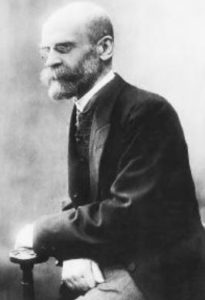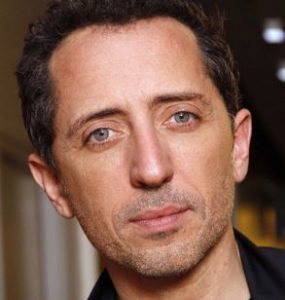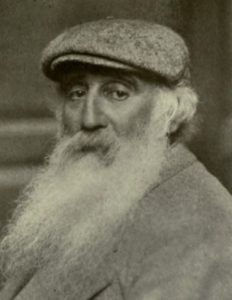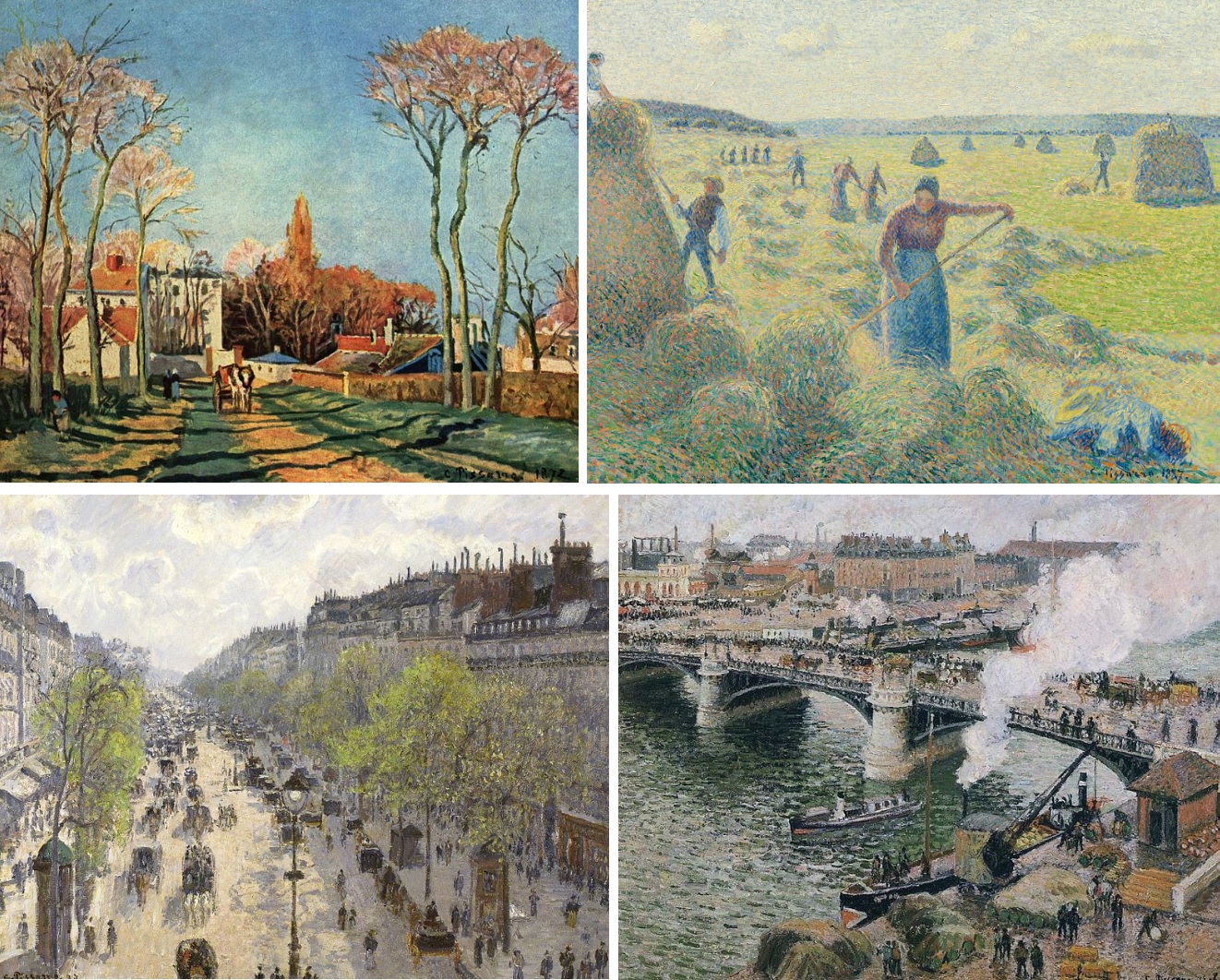The Father of Sociology

Émile Durkheim
David Émile Durkheim (1858-1917) was born in the French region of Lorraine to Orthodox Jewish parents. His father and grandfather were both rabbis, and Durkheim spent his early years in yeshiva intent on becoming a rabbi as well. Eventually, he decided to switch his career path and break out on his own. He went off to study psychology and philosophy. At 21, on his third application attempt, he was accepted to ENS, the most prestigious graduate school in Paris. Durkheim wanted to apply what he learned to explain society and social behaviour. At the time, however, there were no sociology studies anywhere in France. In 1885 he moved to Germany to work alongside some of the first sociologists. Two years later, Durkheim’s papers had become famous across Europe, and he was invited back to France to teach sociology at the University of Bourdeaux. Durkheim taught the first social science course in French history, and was also asked to reform France’s school curriculum. Over the next few years, Durkheim published a series of manifestos outlining exactly what social science is, and why it is important. He showed how the scientific method could be rigorously applied to this new field, and how it was distinct from related subjects. In 1895, he established the first university social science department, and in 1898 founded the first sociology academic journal. For these reasons, Durkheim is often called the “father of sociology”. His work is also credited with pioneering the field of criminology, and influencing psychology and philosophy as well. In 1902, Durkheim was appointed Chair of Education at the world-famous Sorbonne, and later became the only professor whose courses were mandatory for all students. Meanwhile, he served as advisor to France’s Minister of Education. Unfortunately, World War I had a devastating effect on Durkheim. Right-wing nationalists attacked him for not being “patriotic” enough, for being too liberal, and for being Jewish. Worse, many of his students were conscripted and died in the trenches. The final tragedy was the death of his own son. Durkheim fell terribly ill, and ultimately died from a stroke. Despite abandoning formal religion in his youth, he argued that religion is the most important social institution, and the key to a well-functioning “organic” society. He worried greatly about the rising trend of science and the “cult of the individual” taking the place of religion. Durkheim coined the popular term “collective consciousness” (among many others), and was the founder of the school of structural functionalism. Durkheim’s work has influenced countless thinkers, and still serves as the foundation of sociology today.
Words of the Week
Religion gave birth to all that is essential in the society.
– Émile Durkheim

 Gad Elmaleh (b. 1971) was born in Casablanca, Morocco to a traditional Sephardic family. He went to a religious Jewish school (the only one that would have him after being expelled from everywhere else), and spent summers at a Chabad camp. After high school, he studied political science at the University of Montreal. Having grown up in a family of performers, and acting since he was a child, Elmaleh decided to pursue his passion for drama instead. At age 21, he moved to Paris and enrolled at the Cours Florent, one of France’s most prestigious acting schools. Elmaleh became a comedian, and his first stand-up show was a huge success. His second, performed in Paris’ famous Olympia, was even bigger, while his third show drew 300,000 spectators and sold 1.5 million DVDs. His fifth show, in 2007, sold out for weeks, selling over a million tickets. That same year, he was voted the funniest man in France. Elmaleh has been credited with bringing American-style stand-up to the country, and has been called “the French Jerry Seinfeld”. Indeed, Seinfeld was Elmaleh’s greatest inspiration, and the latter would go on to appear on Seinfeld’s show, Comedians in Cars Getting Coffee. (Elmaleh was also the voice of Seinfeld in the French version of Bee Movie.) In 2015, Elmaleh moved to New York and went on his first American tour, “Oh My Gad”. In the past two years, he has had two Netflix specials, in French and in English. He has also performed in Hebrew and in Arabic. Elmaleh has appeared in dozens of films, was awarded the Order of France and the National Order of Quebec, has a child with a European princess (and another with a famous French actress), and is a good friend of (former Jew of the Week)
Gad Elmaleh (b. 1971) was born in Casablanca, Morocco to a traditional Sephardic family. He went to a religious Jewish school (the only one that would have him after being expelled from everywhere else), and spent summers at a Chabad camp. After high school, he studied political science at the University of Montreal. Having grown up in a family of performers, and acting since he was a child, Elmaleh decided to pursue his passion for drama instead. At age 21, he moved to Paris and enrolled at the Cours Florent, one of France’s most prestigious acting schools. Elmaleh became a comedian, and his first stand-up show was a huge success. His second, performed in Paris’ famous Olympia, was even bigger, while his third show drew 300,000 spectators and sold 1.5 million DVDs. His fifth show, in 2007, sold out for weeks, selling over a million tickets. That same year, he was voted the funniest man in France. Elmaleh has been credited with bringing American-style stand-up to the country, and has been called “the French Jerry Seinfeld”. Indeed, Seinfeld was Elmaleh’s greatest inspiration, and the latter would go on to appear on Seinfeld’s show, Comedians in Cars Getting Coffee. (Elmaleh was also the voice of Seinfeld in the French version of Bee Movie.) In 2015, Elmaleh moved to New York and went on his first American tour, “Oh My Gad”. In the past two years, he has had two Netflix specials, in French and in English. He has also performed in Hebrew and in Arabic. Elmaleh has appeared in dozens of films, was awarded the Order of France and the National Order of Quebec, has a child with a European princess (and another with a famous French actress), and is a good friend of (former Jew of the Week) 
 Jacob Abraham Camille Pissarro (1830-1903) was born on the Caribbean island of St. Thomas to a Sephardic Jewish family of Portuguese and French ancestry. Pissarro’s father sent him to a Paris boarding school when he was 12, and it was there that he was first exposed to art, learning to paint and draw. Pissarro returned to St. Thomas at 17 to work in his father’s business, and would spend every spare moment painting. At 21, he became a professional artist and moved to Venezuela, then settled in Paris four years later. There, he apprentice under some of the great painters of the time, including Melbye and Corot. Unlike them, Pissarro wished to paint realistic scenes, and focused on capturing natural landscapes and village life. During this time he met fellow young realists like Monet and Cézanne. Soon, Pissarro was the most famous of them all, with one critic of the day describing him as being able to paint “the smell of the earth”, and another ranking him among the “three or four true painters” of the time. During the Franco-Prussian War, Pissarro lived in a village near London and experimented with a new style that would later be called Impressionism. Upon returning to France years later, Pissarro found that only 40 of his paintings survived the war out of a total 1,500 – twenty years worth of art. Frustrated by the Paris Salon that set standards in art and alone determined whose work could be exhibited, Pissarro decided to start a new art society. He recruited fifteen fellow painters to do so. The others would see him as a father figure, especially because of his long, grey beard (despite being as young as they were). He was described as having the “look of an ancestor who remained a young man”. In 1874, the new society held their first exhibit to display their new form of Impressionist art. For several years afterwards, Impressionism was a very controversial style, with critics either absolutely loving it or hating it. Pissarro would later be credited as “the first Impressionist”. Meanwhile, he became a hero for all young painters for taking a stand against the Salon. Pissarro left the Impressionist fold shorty after, and began to study under painters of the pointillist style. He would go on to fuse the two styles into Neo-Impressionism. By this point, Pissarro was seen as perhaps the most versatile painter in the world, with an “extraordinary capacity to change his art”. In 1884, he took a young Vincent van Gogh as an apprentice. Pissarro continued to paint until the last days of his life, despite a chronic eye infection that weakened his vision, and the persistent financial struggles he faced his entire life. Pissarro was known for his youthful energy, his warmth, humility, wisdom, and gracefulness. Cézanne considered him like a father, and said of Pissarro that he was “a little like the good Lord.” While his works didn’t sell so well in his own lifetime, they are among the most coveted in the world today. One of his paintings was auctioned off for a whopping £19.9 million in 2014. Four of Pissarro’s seven children became noted painters of their own, as are a number of his great-great-grandchildren today.
Jacob Abraham Camille Pissarro (1830-1903) was born on the Caribbean island of St. Thomas to a Sephardic Jewish family of Portuguese and French ancestry. Pissarro’s father sent him to a Paris boarding school when he was 12, and it was there that he was first exposed to art, learning to paint and draw. Pissarro returned to St. Thomas at 17 to work in his father’s business, and would spend every spare moment painting. At 21, he became a professional artist and moved to Venezuela, then settled in Paris four years later. There, he apprentice under some of the great painters of the time, including Melbye and Corot. Unlike them, Pissarro wished to paint realistic scenes, and focused on capturing natural landscapes and village life. During this time he met fellow young realists like Monet and Cézanne. Soon, Pissarro was the most famous of them all, with one critic of the day describing him as being able to paint “the smell of the earth”, and another ranking him among the “three or four true painters” of the time. During the Franco-Prussian War, Pissarro lived in a village near London and experimented with a new style that would later be called Impressionism. Upon returning to France years later, Pissarro found that only 40 of his paintings survived the war out of a total 1,500 – twenty years worth of art. Frustrated by the Paris Salon that set standards in art and alone determined whose work could be exhibited, Pissarro decided to start a new art society. He recruited fifteen fellow painters to do so. The others would see him as a father figure, especially because of his long, grey beard (despite being as young as they were). He was described as having the “look of an ancestor who remained a young man”. In 1874, the new society held their first exhibit to display their new form of Impressionist art. For several years afterwards, Impressionism was a very controversial style, with critics either absolutely loving it or hating it. Pissarro would later be credited as “the first Impressionist”. Meanwhile, he became a hero for all young painters for taking a stand against the Salon. Pissarro left the Impressionist fold shorty after, and began to study under painters of the pointillist style. He would go on to fuse the two styles into Neo-Impressionism. By this point, Pissarro was seen as perhaps the most versatile painter in the world, with an “extraordinary capacity to change his art”. In 1884, he took a young Vincent van Gogh as an apprentice. Pissarro continued to paint until the last days of his life, despite a chronic eye infection that weakened his vision, and the persistent financial struggles he faced his entire life. Pissarro was known for his youthful energy, his warmth, humility, wisdom, and gracefulness. Cézanne considered him like a father, and said of Pissarro that he was “a little like the good Lord.” While his works didn’t sell so well in his own lifetime, they are among the most coveted in the world today. One of his paintings was auctioned off for a whopping £19.9 million in 2014. Four of Pissarro’s seven children became noted painters of their own, as are a number of his great-great-grandchildren today.